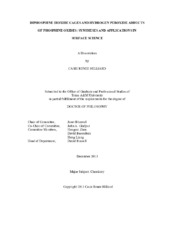| dc.description.abstract | Understanding the adsorption of phosphine oxides on silica surfaces has a threefold incentive. (a) Efficiently removing phosphine oxides from reaction mixtures is crucial after many synthetic procedures, for example the Wittig reaction. (b) Using the P=O group for probing the surface acidity of oxides. (c) Most importantly, getting more insight regarding the nature of the P=O/surface interaction. Hereby, the mobility of the adsorbed species is of fundamental interest. In the classical 31P MAS and in HRMAS NMR spectra the reduction of the originally large CSA, the residual halfwidth, as well as the downfield shift of the signals when adsorbing phosphine oxides on silica surfaces are most indicative. This research provides new insights regarding the strength of the phosphine oxide adsorption on various silica surfaces and the diverse modes of mobility. Furthermore, an oxidation procedure for the synthesis of a variety of phosphine oxides, including the model compounds used for the adsorption studies, has been developed. It yields the well-defined H2O2 adducts as key intermediates, which have been fully characterized and methods for their controlled and efficient decomposition are described. For adsorbed phosphine oxides, the changes of the 31P solid-state NMR signals as compared to the polycrystalline materials can stem from both the translational mobility of the compound across the silica surface and the interaction of the P=O group with the silanol groups of the silica. Molecules containing two phosphine oxide groups, one of them being sterically prevented from interacting with the surface, are target compounds for the adsorption studies. Since the P nuclei are bound within the same molecule, both experience the same translational mobility, but only one P=O group can undergo quaternization by contact with the surface. Therefore, the contribution of each factor to the CSA reduction upon adsorption can be determined. The diphosphine cages and their dioxides can serve as such probe molecules and their adsorption on silica has been examined.
Since none of these small cages, containing five to twelve methylene groups in each alkyl chain, are presently known in the literature, a new synthetic route to access the diphosphine cage derivatives, namely the dioxide cages, had to be explored. Employing Fe gyroscopes as starting materials and releasing the phosphine oxides from the metal center to form the dioxide cage molecules is most effective and will be highlighted. Having synthesized the diphosphine dioxide cages, their 31P MAS NMR characteristics in the polycrystalline and surface-adsorbed states will be discussed in detail. In summary, the two largest diphosphine dioxide cages adsorbed on silica only show one signal in the 31P solid-state NMR spectra, indicating both sides of each cage are interacting with the support. On the other hand, the smallest cage, containing 10 methylene groups in each alkyl chain, when adsorbed results in two distinct signals in the 31P solid-state NMR spectra, meaning one P=O group is adsorbed on the support while the other is pointing away from the surface, as desired. Examining the different CSA values of the two signals proves that both the translational mobility and partial quaternization effect play a role in the overall CSA reduction for the adsorbed species. | en |


